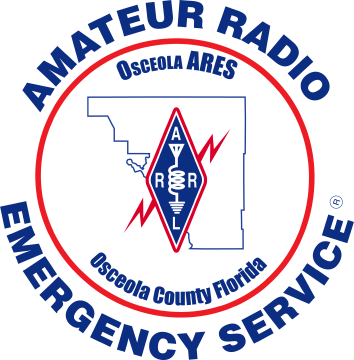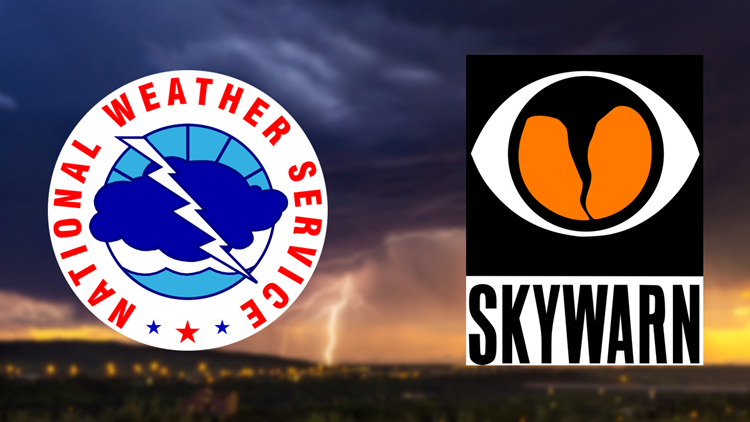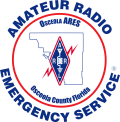We have two repeaters for ARES and local use. The repeater site is located between St.Cloud and Kissimmee.
Analog Repeaters
| ID | Frequency | Offset | Tone |
|---|---|---|---|
| KG4EOC | 145.350 | DUP- | 103.5 |
An analog ham radio repeater is a type of amateur radio repeater that operates using traditional analog modulation and demodulation techniques. Unlike digital repeaters that use digital voice and data protocols, analog repeaters use analog FM (Frequency Modulation) modulation for voice communications.
Here’s how an analog ham radio repeater works:
- Simplex Communication: When two ham radio operators communicate directly with each other, it’s called simplex communication. However, the range of handheld or mobile ham radios is limited due to their power and antenna height. To extend communication range, repeaters are used.
- Repeater Setup: A repeater consists of two key components: a receiver and a transmitter. The receiver listens on a specific frequency (input frequency) for incoming signals from nearby ham radios. When it receives a signal, it amplifies it and retransmits it on a different frequency (output frequency) using its transmitter.
- Duplex Operation: The process of receiving on one frequency and transmitting on another frequency simultaneously is known as duplex operation. The input and output frequencies are separated by a fixed frequency offset, often referred to as the “split.”
- Offset and Tone Access: To prevent interference between nearby repeaters, each repeater has a unique split frequency (offset) and may require a specific sub-audible tone (CTCSS or PL tone) to access the repeater. This tone access ensures that only signals with the correct tone are retransmitted by the repeater.
- Extended Range: By placing repeaters on elevated locations such as mountains or tall buildings, the communication range of handheld and mobile radios can be significantly extended. Hams can use their handheld or mobile radios to communicate with the repeater, which then retransmits their signals over a wider area.
- Communication Reach: Analog repeaters are generally limited to local or regional communication due to their reliance on line-of-sight propagation and the specific geography of their coverage area.
Analog ham radio repeaters have been an essential part of amateur radio infrastructure for many years. They provide a means for hams to communicate over extended distances without needing expensive high-power radios or antennas. However, with the advent of digital modes like D-STAR, DMR, and others, digital repeaters are becoming more popular, offering enhanced audio quality, data capabilities, and internet linking features.
Digital Repeaters
| ID | Frequency | Offset | Protocol |
|---|---|---|---|
| KG4EOC B | 444.100 | DUP+ | D-STAR |
DCS102 Reflector
| Module | Name |
|---|---|
| DCS102 B | Hang Out |
| DCS102 E | EMCAT |
| DCS102 W | Weather Watch |
A D-STAR (Digital Smart Technologies for Amateur Radio) repeater is a type of amateur radio repeater that operates using the D-STAR digital voice and data protocol. D-STAR is a digital communication system developed for amateur radio by the Japan Amateur Radio League (JARL) and provides advanced voice, data, and networking capabilities for ham radio operators.
Here’s how a D-STAR repeater works:
- Digital Voice Communication: D-STAR repeaters allow hams to communicate digitally, providing clearer audio quality compared to traditional analog FM repeaters. The digital voice stream is encoded and decoded using specific protocols that enhance audio clarity and reduce noise.
- Data Communication: D-STAR supports data transmission alongside voice communication. This enables text messaging, GPS position reporting, and other data-related features that can be useful during emergency communications and public service activities.
- Internet Connectivity: One of the unique aspects of D-STAR is its ability to link repeaters over the internet. Through this network, called the D-STAR Gateway, hams can communicate beyond the range of a single repeater. This linking capability extends the reach of D-STAR repeaters globally, enabling worldwide communication between D-STAR users.
- Reflectors: D-STAR repeaters can be connected to virtual rooms called “reflectors,” which act as hubs for D-STAR users to meet and communicate. Reflectors allow multiple repeaters and individual D-STAR radios to be linked together, creating larger networks and facilitating group conversations.
- Callsign Routing: D-STAR repeaters and radios use a system called “callsign routing,” where each D-STAR device is assigned a unique 8-character callsign. Instead of using a frequency and a tone, like in traditional analog repeaters, D-STAR repeaters are accessed by specifying the destination callsign.
D-STAR repeaters have been widely adopted by the amateur radio community, especially in regions with active D-STAR infrastructure. They offer numerous advantages for hams, including improved audio quality, data capabilities, and the ability to participate in global communications via the internet. However, it’s essential for users to be aware of local regulations and licensing requirements regarding the use of digital modes and internet-linked repeaters.


